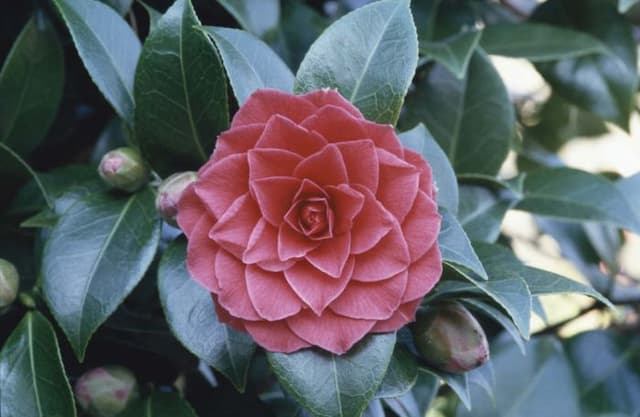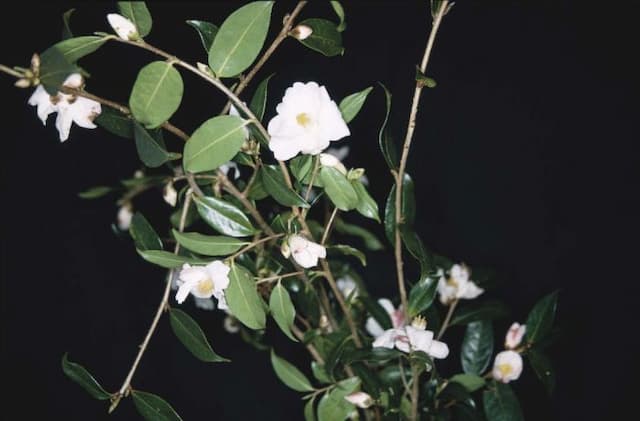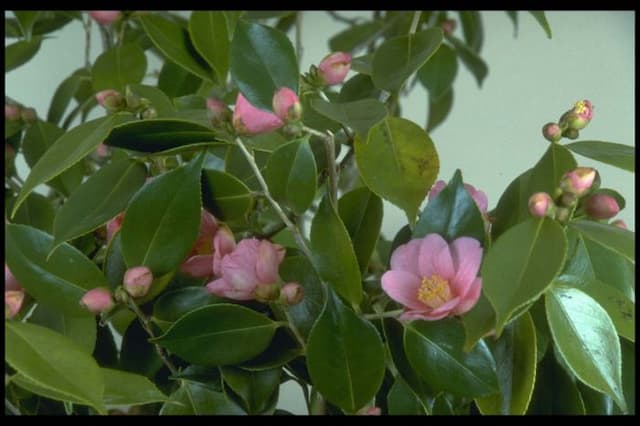Japanese Camellia Camellia japonica 'Lovelight'

ABOUT
The Camellia japonica 'Lovelight' is an ornamental plant with a refined and elegant appearance. Its most striking feature is the beautiful flowers it produces. These blooms are large, with a diameter that captures attention, showcasing a dazzling display of petals. The color of the flowers is typically a captivating shade of pink, varying from pale to a more rich intensity, which imbues gardens with a romantic ambiance. The flowers are further characterized by a symmetrical arrangement of petals that closely overlap, forming a distinctive formal double shape that resembles some of the most classic and revered flower forms. The lustrous petals have a waxy texture that adds to their sophisticated look, gleaming under the sunlight like smooth porcelain. Surrounding these gorgeous blooms, the plant boasts glossy, evergreen leaves providing a lush backdrop. These leaves are dark green, leathery to the touch, with a slightly serrated edge adding subtle textural interest to the plant's overall appearance. The foliage is dense, creating a full and vibrant canopy throughout the year, which makes the Camellia japonica 'Lovelight' not just a seasonal stunner but a year-round centerpiece in gardens and landscaped areas. Throughout its blooming season, the plant can become a focal point in a garden, offering a continuous display of stunning flowers that can be enjoyed from late winter through the spring, providing a bridge of beauty between the seasons. The overall aesthetic of the Camellia japonica 'Lovelight' is one of timeless elegance, making it a beloved choice for garden enthusiasts looking to add a touch of classic charm to their surroundings.
About this plant
 Names
NamesFamily
Theaceae
Synonyms
Japanese Camellia, Rose of Winter, Tsubaki
Common names
Camellia japonica 'Lovelight'.
 Toxicity
ToxicityTo humans
Camellia japonica, commonly known as the Japanese camellia, is not considered toxic to humans. There are no significant symptoms of poisoning associated with this plant, as it is generally regarded as non-poisonous. Ingesting parts of this plant should not result in harmful consequences, but as with any non-food plant, consuming large amounts may cause discomfort or an upset stomach due to the plant material's roughage and non-digestible components.
To pets
The Japanese camellia is not toxic to pets. It is not known to cause poisoning in dogs, cats, or other household pets. There should be no symptoms of poisoning if a pet were to ingest parts of the plant. However, it's advisable to prevent pets from eating non-food plants as they could potentially cause an upset stomach or an intestinal blockage.
 Characteristics
CharacteristicsLife cycle
Perennials
Foliage type
Evergreen
Color of leaves
Varies
Flower color
Pink
Height
6-10 feet (1.8-3 meters)
Spread
6-10 feet (1.8-3 meters)
Plant type
Shrub
Hardiness zones
7
Native area
Japan
Benefits
 General Benefits
General Benefits- Aesthetic Appeal: Adds vibrant color and ornamental beauty to gardens with its bright, semi-double flowers.
- Year-Round Interest: Offers glossy, evergreen foliage that provides a backdrop to its seasonal blooms.
- Low Maintenance: Requires minimal pruning and care once established, making it suitable for busy gardeners.
- Hardiness: Resilient to cold temperatures, typically thriving in USDA zones 7-9.
- Versatility: Can be used in various landscape designs, including as a specimen plant, in mixed borders, or as foundation plantings.
- Habitat Support: Attracts pollinators such as bees, providing ecological benefits to the garden environment.
 Medical Properties
Medical PropertiesThis plant is not used for medical purposes.
 Air-purifying Qualities
Air-purifying QualitiesThis plant is not specifically known for air purifying qualities.
 Other Uses
Other Uses- Crafting Dyes: Camellia japonica 'Lovelight' petals can be used to create natural dyes for fabrics and textiles.
- Floral Arrangements: The bright, large blooms are popular in decorative displays and can add elegance to any floral arrangement.
- Culinary Decor: Edible varieties of the petals can be candied for use in baking or as a decorative edible garnish on fine dishes.
- Photography: This variety is often sought after by photographers for its luminous and vibrant flowers, ideal for nature photography.
- Art Inspiration: Artists may use the plant as a subject or inspiration for paintings, drawings, and other forms of visual art.
- Wedding Decor: Due to its romantic connotations and stunning flowers, it can be used in wedding bouquets and venue decorations.
- Handmade Paper: The fibers from Camellia japonica 'Lovelight' can be incorporated into paper making for added texture and visual interest.
- Religious Ceremonies: In some cultures, flowers from the Camellia japonica may be used in various religious or ceremonial contexts.
- Educational Tool: Horticulture programs may utilize the plant to teach students about care, propagation, and the history of camellias.
- Perfumery: While not a traditional source, the subtle fragrance of Camellia japonica 'Lovelight' could inspire scents in perfumery.
Interesting Facts
 Feng Shui
Feng ShuiThe Camellia is not used in Feng Shui practice.
 Zodiac Sign Compitability
Zodiac Sign CompitabilityThe Camellia is not used in astrology practice.
 Plant Symbolism
Plant Symbolism- Adoration: Often associated with deep longing and desire, Camellia japonica 'Lovelight' represents the feeling of adoration for someone, reflecting the plant’s lush and attractive blossoms.
- Perfection: The camellia's beauty and perfectly formed blooms have made it a symbol of ideal beauty and perfection, often presented as a gift to express admiration for someone’s flawless qualities.
- Longevity and Faithfulness: Known for its ability to live for a long time and bloom consistently throughout the seasons, the camellia symbolizes the endurance of love and faithfulness in relationships.
- Devotion: With its rich, full petals and strong evergreen nature, the camellia epitomizes the spiritual and emotional devotion one might have for another, making it a heartfelt gift between lovers or friends.
 Water
WaterFor the Japanese Camellia, it is important to maintain evenly moist soil, especially during dry spells. Water the plant deeply once a week, providing about one to one and a half gallons of water each time, depending on weather conditions and soil drainage. Reduce watering during the winter months when the plant is not actively growing. Ensure that the soil is well-draining to avoid waterlogging, which can lead to root rot. During the growing season in spring and summer, make sure to water consistently if rainfall is not sufficient.
 Light
LightJapanese Camellias thrive in partial shade, where they can receive filtered sunlight. The ideal location would be under the canopy of tall trees that provide dappled sunlight throughout the day. Avoid placing it in direct afternoon sun, which can scorch the leaves and flowers of the plant. Morning light or late afternoon sun with shade during the peak intensity hours is optimal for the health and blooming of the camellia.
 Temperature
TemperatureJapanese Camellias prefer a temperature range between 60 to 80°F for optimal growth. They can tolerate minimum winter temperatures down to around 20°F but should be protected from cold, drying winds. To ensure healthy growth and blooming, maintain temperatures within the ideal range, avoiding sudden temperature fluctuations.
 Pruning
PruningPrune Japanese Camellias after they finish blooming to shape the plant and remove dead or weak wood. Thin out crowded branches to enhance air circulation. Pruning is typically done in late winter or early spring. Remove spent flowers to promote more buds and maintain plant appearance. Avoid heavy pruning as this can reduce flowering in the next season.
 Cleaning
CleaningAs needed
 Soil
SoilThe Japanese Camellia 'Lovelight' prefers a well-draining, acidic soil mix with a pH range of 5.5 to 6.5. An ideal soil mix could be one part peat moss, one part pine bark, and one part perlite or coarse sand to ensure proper drainage and aeration.
 Repotting
RepottingJapanese Camellias like 'Lovelight' should be repotted every 2-3 years, preferably in the spring after blooming. Younger plants may require more frequent repotting as they grow, while mature plants can be repotted less often.
 Humidity & Misting
Humidity & MistingJapanese Camellia 'Lovelight' thrives best in moderate to high humidity, ideally around 50-70%. They benefit from a humid environment but can tolerate lower humidity with care.
 Suitable locations
Suitable locationsIndoor
Place in bright, indirect light and keep soil moist.
Outdoor
Partial shade, sheltered from strong winds, mulch well.
Hardiness zone
7-9 USDA
 Life cycle
Life cycleThe life of Camellia japonica 'Lovelight', commonly known as Japanese camellia, begins with seed germination, which occurs in a warm, moist environment, preferably in spring. After germination, the seedling grows into a young plant, developing its first true leaves and gradually maturing over several years. The camellia enters a vegetative stage, where it focuses on producing a robust network of branches and evergreen foliage. As the plant matures, typically between 2 to 5 years after planting, it enters the reproductive phase, producing ornate, light pink flowers, usually in late winter to early spring, depending on the climate. After pollination, which can be done by bees and other insects, the flowers give way to seed capsules, which, when mature, release seeds to start a new generation. The plant then enters a period of dormancy, usually during the colder months, before recommencing the growth cycle in the next season.
 Propogation
PropogationPropogation time
Spring-Early Summer
Propogation: Camellia japonica 'Lovelight', commonly known as the Japanese camellia, is often propagated by semi-hardwood cuttings. For this variety, the best time to take cuttings is in late summer when the current season's growth has begun to mature. Cuttings should be about 4 to 6 inches long with several leaves, and the lower end should be cut just below a node. It is recommended to dip the cut end in rooting hormone to increase the chances of successful root development. The cuttings are then placed in a well-drained soil mix and kept humid, often using a plastic cover to maintain moisture levels. A rooting temperature of around 70°F (21°C) is considered ideal. It can take several weeks to a few months for cuttings to root well, after which they can be transplanted into individual pots.









